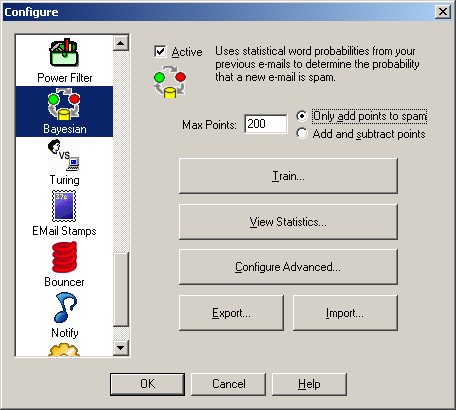The Bayesian Analyzer does this. It looks at your previous e-mail and learns the characteristics of spam and good e-mail. Just like a baby, it needs to be taught right from wrong. By marking your messages as Good or Spam, and then Train the Bayesian Analyzer, you can teach it right from wrong. Then it can contribute to the decision of whether a new e-mail is spam or not.
|
|

|
|
|
| The Bayesian Analyzer uses statistics to determine whether an e-mail is spam based on analysis of previous e-mails. We have included a brief description of how it works.
|
|
|
| Max Points - sets the maximum number of points that the Bayesian Analyzer can contribute the spam score. If the Bayesian Analyzer is not certain, then only a couple of points might be added or deducted.
|
|
|
| Only add points to spam - Setting this option will cause the Bayesian Analyzer to only add to the spam score. The number of points it adds is determined by the statistical analysis.
|
|
|
| Add and subtract points - Setting this option will allow the Bayesian Analyzer to add points for spam and deduct points if the e-mail message is determined statistically to be a good message. With this option set, the Bayesian Analyzer can add or deduct Max Points.
|
|
|
| You must train the Bayesian analyzer with previous e-mails. Training is not difficult, but it does require that you correct any mistakes that Spam Sleuth Enterprise might have made in the past. You must also let Spam Sleuth Enterprise keep your good e-mail so that it has both spam and good e-mail with which to train.
|
|
|
| Steps:
|
| 1. | Turn on 'Score and store non-spam messages'.
|
| 2. | Correct any mistakes by using Mark as Good and Mark as Spam.
|
| 3. | Hit the Train button
|
|
|
|
|
| Train - Lets you train the analyzer with previous e-mails.
|
|
|
| View Statistics - Lets you see how many e-mails have been trained and the distribution of probabilities.
|
|
|
| Export... - Export the word probabilities to a comma separated (.CSV) file.
|
|
|
| Import... - Import the word probabilities from a comma separated (.CSV) file.
|
|
|
|
|